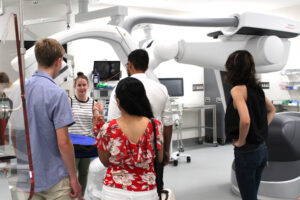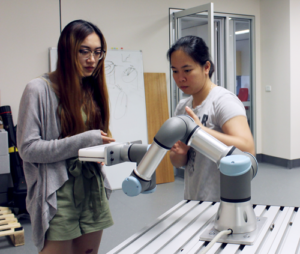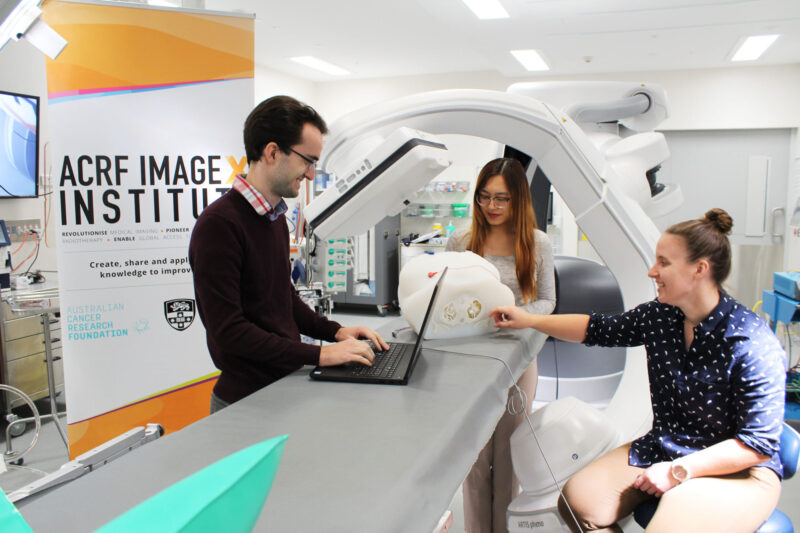Each year Image X Institute offers a Summer Research Program, running across January and February.
These scholarships provide an opportunity for students studying at the University of Sydney to undertake a summer vacation research project with investigators in our research program.

Especially suited to students with a background in subjects including (but not limited) to:
- Physics
- Mathematics
- Computer science
- Biomedical engineering
- Electrical engineering

Image X prides itself on offering a summer research program filled with opportunities. Students can work onsite amongst our multidisciplinary team, learning about the different projects and careers within our group. We host social activities, tours of our research facilities, as well as an introductory seminar series about radiation therapy and cancer imaging, presented by our star researchers. Many summer students continue working with Image X after their projects, from taking on part time research positions through to commencing PhD projects.
Successful applicants will be invited to choose from the projects below (please note, more projects will be added in the next month). Scholarships will be awarded based on the student’s academic transcript, relevant academic background or any research experience.
Apply for 2026
Applications for 2025 scholarships closed on September 14th 2025.
Check back in August 2026 to find out about applying for the next round.
Watch a quick video to meet some former summer students here:
Current Projects
More projects will be added in September/October
Advanced neural representations for AI-guided tumour and organ-at-risk tracking
Supervisors: Dr Nicholas Hindley, Dr Chandrima Sengupta
Project description:
Lung cancer is the leading cause of cancer-related death and the fifth most commonly diagnosed cancer in Australia. 77% of lung cancer patients will benefit from radiotherapy and hypofractionated treatments, where high doses are delivered in concentrated treatment sessions, have been shown to improve overall survival with 10 times fewer hospital visits. However, 1 in 2 lung cancer patients are ineligible for these highly effective treatments, because they suffer from metastases and we currently cannot adapt hypofractionated treatments to multiple independently-moving targets as patients breathe.
To maximise access to the most effective treatments while minimising radiation-induced toxicities, we invented Voxelmap, an open-source artificial intelligence system that tracks tumours and organs-at-risk during lung cancer radiotherapy (https://github.com/Image-X-Institute/Voxelmap). So far we have published results on the performance of Voxelmap using computer-generated data. In this exciting project, we will incorporate cutting-edge work on implicit neural representations to enhance the performance of Voxelmap.
Given the aims of the project, experience with Python/MATLAB coding is a must and familiarity with machine learning frameworks (such as Pytorch) is a definite bonus! Having said that, we are willing to coach a motivated student.
Spatially aware neural networks for deep-learning based tumour motion monitoring
Supervisors: Dr Nicholas Hindley, Dr Chandrima Sengupta, Dr Zhuang Xiong
Project description:
During radiotherapy, lung tumours move significantly from the planned treatment position. As a result, the radiation beam may miss the tumour and hit nearby healthy tissues, resulting in poor treatment outcomes.
This project will develop and evaluate a deep-learning based tumour tracking algorithm that incorporates gantry angles and projection matrices to become spatially aware. Conditional Generative Adversarial Networks (cGANs) will be used for image segmentation. The method developed during this project will be investigated through a real-time framework for its clinical implementation.
Development of a wearable for respiration and cardiac monitoring during CT image acquisition.
Supervisors: Dr Mark Gardner
Project description:
Acquiring an accurate CT image of a patient is an important part of planning radiation therapy treatments. However, breathing and heart motion can cause blurring in the image acquisition, making it difficult to identify key anatomical landmarks in acquired CT images.
In this project you will develop a device that is placed onto a patient whilst they are having a CT scan. The device can detect breathing and heart motion using accurate and high frequency motion sensors. The motion sensor data will then be sent wirelessly to an external computer and will be analysed to detect patient breaths and heart beats.
The acquisition of this breathing and heartbeat data will allow us to develop image acquisition methods that compensate for breathing and heart motion, allow for more accurate CT images, leading to better radiation therapy planning and better treatment outcomes.
Experience in coding preferred but not necessary. No other prior knowledge needed.
Parahydrogen hyperpolarized nuclei for MRI-guided radiotherapy
Supervisors: Dr Thomas Boele, Dr David Waddington
Project description:
Better diagnostic imaging and biologically targeted radiotherapy can improve cancer patient outcomes. Magnetic resonance imaging (MRI) provides high resolution images with excellent soft tissue contrast for clinical diagnosis. MRI-guided radiotherapy has emerged as a clinical tool in the last decade as treatment devices combining imaging and targeting have become available to oncology departments.
However, MRI is limited by its low sensitivity, inherent to the technique’s reliance on the small net magnetic moment of ensembles of nuclear spins in biological systems. Hyperpolarization techniques can boost the available MR signal by greater than four orders of magnitude to enable imaging modalities that are impractical or impossible with traditional methods.
In this project we aim to build hardware to develop a flexible and low-cost approach based on the transfer of quantum spin order from parahydrogen to the nuclei of interest to enhance access to cutting edge hyperpolarization technology. There are multiple directions of research available for a student interested in exploring the intersection between engineering, quantum physics and medical imaging.
Improved Speech Imaging with Real-Time MRI
Supervisors: Dr David Waddington
Project Description:
Speech is a crucial aspect of human communication, yet there is still much to learn about how people shape their vocal tract during speech production. While MRI technology has the potential to provide detailed images of speech, current real-time MRI techniques are too slow to capture the rapid movements involved.
This project aims to utilize advanced reconstruction techniques to enhance the quality and speed of videos showing people speaking while in an MRI scanner. Students with a background in mathematics, engineering, physics, and coding (Python and/or MATLAB) will be well-suited for this project. By the end of the project, the student will produce a comparative analysis of various image reconstruction methods and a set of real-time videos showing human speech. This project is a collaboration with the Discipline of Speech Pathology and the School of Electrical and Computer Engineering.
The impact of low dose CT on CT ventilation image quality in the context of lung cancer screening programs
Supervisors: Prof Paul Keall, Dr Hunor Kertesz, Jeremy Lim
Project description:
Computed tomography ventilation imaging (CTVI) is a fast growing clinical modality. CTVI has been applied across respiratory diseases, including lung cancer, interstitial lung disease and idiopathic pulmonary fibrosis. The first CTVI product was FDA-approved in 2023.
Also, increasing are national lung cancer screening programs. The US National Lung Screening Trial found from over 50,000 persons at high risk for lung cancer that screening reduced mortality. Based on the findings, the US National Comprehensive Cancer Network (NCCN) guidelines recommended low dose CT for patients at high risk of lung cancer.
A feature of lung cancer screening programs is that, to balance the costs and benefits of CT imaging, low dose CT scans are used. These scans have increased noise compared with standard CT scans and may impact the quality and accuracy of the CTVI derived from the scans. However, to date, no dedicated studies investigating the impact of low dose CT on CTVI quality have been performed.
Therefore, to address the knowledge gap, the aim of this project is to quantify the impact of low dose CT on CTVI quality in the context of pairing CTVI with lung cancer screening programs.
